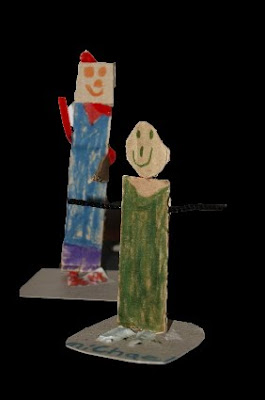Thursday, February 25, 2010
First and Second Grade Cardboard and Wire Figures Inspired by Calder's Circus
Students watched "Cirque de Calder" and were inspired to use cardboard and wire to create some circus characters of their own. These sad and happy clowns were created by our first and second graders. The grouchy clown is wearing boxing gloves, red shoes, and a grouch hat. See the rest of the gang on display in the lobby. Stop back often and watch the circus grow! Our students really enjoyed watching "Cirque de Calder" in it's entirety. You can check out a clip here: http://www.youtube.com/watch?v=MWS96nzFUks
Thursday, February 11, 2010
Sandy's Circus
I'm a great fan of Alexander Calder's work, and so I learned, is our librarian. When our librarian mentioned that she was reading the Red Clover Book nominee "Sandy's Circus", by Tanya Lee Stone, to our students this week; I was thrilled. "Sandy's Circus" is a children's picture book about Calder's fantastic cork and wire creation.
Now, can you guess what we're doing in the art room this week? Our kids have watched "Cirque de Calder" and a power point presentation on mobiles, stabiles, and wire sculpture, and we've moved on to building cardboard and wire figures, and desktop mobiles.
Grades 3 and 4 built the mobiles shown above. Wonderful and whimsical! I'll post the figures after the break.
If you'd like to learn more about Red Clover Book Awards and this year's nominees, check this link: http://www.underhillid.k12.vt.us/Max/RedClover.html
Calder's wire circus is on display at the Whitney Museum in NYC. Maybe we'll get down there to see it during the break.
Thursday, February 4, 2010
African Masks Inspire Us
Fourth, fifth and sixth graders took a break from making Haiti House pins, and used some of the their previously decorated papers to create these colorful masks. Before work began, we discussed reasons why people around the world might wear or use a mask. Some of the reasons mentioned were to change or hide identity, for protection, for fun, and for spiritual or ceremonial reasons. For inspiration, we looked at a selection of African mask designs.
Students completed a rough draft of a mask that would show an alternate or secret side of themselves. We reviewed bilateral symmetry and after a quick demonstration on cutting symmetrical shapes, students were ready to go. The students selected their papers and began turning their designs into masks. The expectation was that the would mix and layer papers to create visual interest. When we met for the third week students were asked to break out of the outline of their mask by adding fringe, feathers, raffia, etc.
By the looks of things our students have very wild and colorful inner lives! It was great to share this project with the students and fun for all. They will look great at the art show.
Students completed a rough draft of a mask that would show an alternate or secret side of themselves. We reviewed bilateral symmetry and after a quick demonstration on cutting symmetrical shapes, students were ready to go. The students selected their papers and began turning their designs into masks. The expectation was that the would mix and layer papers to create visual interest. When we met for the third week students were asked to break out of the outline of their mask by adding fringe, feathers, raffia, etc.
By the looks of things our students have very wild and colorful inner lives! It was great to share this project with the students and fun for all. They will look great at the art show.










